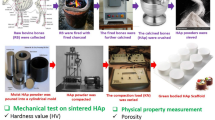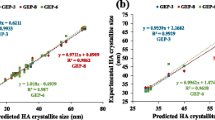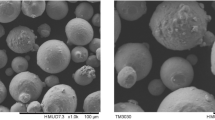Abstract
Porosity plays a vital role in the field of bio-medical engineering of implantations i.e. orthopedic and orthodontics. Shape memory alloys exhibit a greater strength with a higher porosity. The strength of porous shape memory alloys were found similar to the strength of bones. In the present research, NiTi SMA is fabricated by powder metallurgy process. The processing parameters of sintering and compaction (i.e. compaction pressure, sintering temperature and sintering time) play an important role in the porosity investigation of SMA. Taguchi’s method based \(\hbox {L}_{9}\) orthogonal array was selected for the planning of experiments. Sintering temperature and sintering time were the significant process parameters as compared to compaction pressure. Regression coefficients and equation was derived by use of regression analysis. Further this equation was solved with the help of genetic programming and results of both (i.e. Taguchi’ method and genetic programming) were compared to find the maximum porosity. The maximum porosity that can be achieved is 56 % and the confirmation experiments were performed at 95 % confidence level.




Similar content being viewed by others
References
Banhart, J. (2000). Properties and applications of cast aluminum sponges. Advanced Engineering Materials, 2, 188–191.
Bouacha, K., Athmane Yallese, M., Mabrouki, T., & Rigal, J. F. (2010). Statistical analysis of surface roughness and cutting forces using response surface methodology in hard turning of AISI 52100 bearing steel with CBN tool. International Journal of Refractory Metals & Hard Material, 28, 349–361.
Catauro, M., Raucci, M. G., Continenza, M. A., & Marotta, A. (2004). Biocompatibility tests with fibroblasts of CaO rich calcium silicate glasses. Journal of Material Science, 39, 373–375.
Cetin, M. H., Ozcelik, B., Kuram, E., & Demirbas, E. (2011). Evaluation of vegetable based cutting fluids with extreme pressure and cutting parameters in turning of AISI 304L by Taguchi method. Journal of Cleaner Production, 19, 2049–2056.
De Jong, K. A. (1975). An analysis of the behavior of a class of genetic adaptive systems. Doctoral dissertation. Department of Computer and Communications Sciences. University of Michigan. Ann Arbor.
Elahinia, M. H., & Ahmadian, M. (2005). An enhanced SMA phenomenological model. Part II. The experimental study. Journal of Smart Material and Structure, 14, 1309–1319.
Frenzel, J., Zhang, Z., Somsen, C., Neuking, K., & Eggeler, G. (2007). Influence of carbon on martensitic phase transformations in NiTi shape memory alloys. Acta Materialia, 55, 1331–1341.
Funakubo, H. (1987). Shape memory alloys. New York: Gordon and Breach Publishers.
Goldberg, D. E. (1989). Genetic algorithms in search, optimization, and machine learning. Massachusetts: Addison Wesley Publishing Reading.
Holland, J. H. (1975). Adaptation in natural and artificial systems. Cambridge: MIT Press.
Horng, J. T., Liu, N. M., & Chiang, K. T. (2008). Investigating the machinability evaluation of Hadfield steel in the hard turning with Al2O3/TiC mixed ceramic tool based on the response surface methodology. Journal of Material Processing Technology, 208, 532–541.
Hosseini, S. A., Yazdani-Rad, R., Kazemzadeh, A., & Alizadeh, M. (2013). Influence of thermal hydrogen treatment of titanium particles on powder metallurgical processing of NiTi-SMA. Materials and Manufacturing Processes, 28, 1179–1183.
Jangra, K. K., Sharma, N., Khanna, R., & Deepak., (2014). An experimental investigation and optimization of friction stir welding process for AA6082 T6 (cryogenic treated and untreated) using an integrated approach of Taguchi, GRA and entropy method. Proceedings of Institution of Mechanical Engineers Part L: Journal of Materials: Design and Applications. doi:10.1177/1464420715578182.
Kabiri, Y., Kermanpur, A., & Foroozmehr, A. (2012). Comparative study on microstructure and homogeneity of NiTi shape memory alloy produced by copper boat induction melting and conventional vacuum arc melting. Vacuum, 86, 1073–1077.
Khanaa, R., Kumar, A., Garg, M. P., Singh, A., & Sharma, N. (2015). Multiple performance characteristics optimization for Al 7075 on electric discharge drilling by Taguchi grey relational theory. Journal of Industrial Engineering International, 11, 459–471.
Lee, K. S., Yang, D. Y., Park, S. H., & Kim, R. H. (2006). Recent developments in the use of two-photon polymerization in precise 2D and 3D microfabrication. Polymers for Advanced Technologies, 17, 72–82.
Li, S., Liu, Y., Li, Y., Landers, R. G., & Tang, L. (2013). Process planning optimization for parallel drilling of blind holes using a two phase genetic algorithm. Journal of Intelligent Manufacturing, 24, 791–804.
Manna, A. K., Das, B., Dey, J. K., & Mondal, S. K. (2016). An EPQ model with promotional demand in random planning horizon: Population varying genetic algorithm approach. Journal of Intelligent Manufacturing. doi:10.1007/s10845-016-1195-0.
Mitsuo, G., & Runwei, C. (1957). Genetic algorithms and engineering design. New York: Wiley-Interscience Publication.
Sharma, N., Raj, T., & Jangra, K. K. (2016). Micro-structural evaluation of niti-powder, steatite and steel balls after different milling conditions. Material and Manufacturing Processes, 31(5), 628–632. doi:10.1080/10426914.2015.1004710.
Sahoo, A. K., & Pradhan, S. (2013). Modeling and optimization of Al/SiCp MMC machining using Taguchi approach. Measurement, 46, 3064–3072.
Sharma, N., Raj, T., & Jangra, K. K. (2015a). Applications of Nickel–Titanium alloy. Journal of Engineering and Technology, 5(1), 1–7.
Sharma, N., Raj, T., & Jangra, K. K. (2015b). Fabrications of Ni–Ti alloys: A review. Proceedings of Institutions of Mechanical Engineers, Part L: Journal of Materials: Design and Applications. doi:10.1177/1464420715622494.
Sharma, N., Khanna, R., & Gupta, R. D. (2015c). WEDM process variables investigation for HSLA by response surface methodology and genetic algorithm. Engineering Science and Technology: An International Journal, 18(2), 171–177.
Tuchinskiy, L. & Loutfy, R. (2003). Titanium foams for medical applications. In Proceedings of ASM conference on materials and processes for medical devices, Anaheim, CA.
Williams, E., Shaw, G., & Elahinia, M. (2010). Control of an automotive shape memory alloy mirror actuator. Mechatronics, 20, 527–534.
Author information
Authors and Affiliations
Corresponding author
Rights and permissions
About this article
Cite this article
Sharma, N., Kumar, K., Raj, T. et al. Porosity exploration of SMA by Taguchi, regression analysis and genetic programming. J Intell Manuf 30, 139–146 (2019). https://doi.org/10.1007/s10845-016-1236-8
Received:
Accepted:
Published:
Issue Date:
DOI: https://doi.org/10.1007/s10845-016-1236-8




